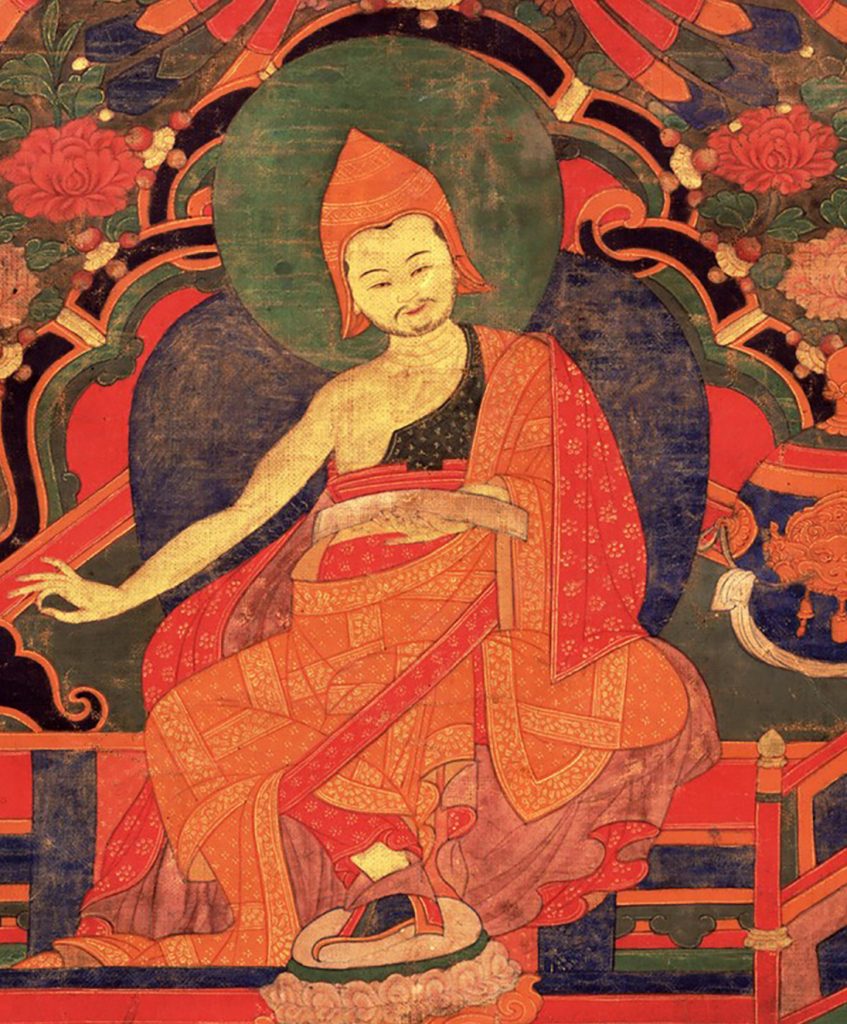Previous Lives
The Last Abbot of Nalanda
Shakyashri Bhadra
 For hundreds of years, illustrious masters travelled from India to Tibet, braving the treacherous conditions to bring with them the greatest treasure of all, the Dharma. Thanks to the courageous compassion of these teachers, Tibet received the sun-like teachings of Buddha. One such master was Shakyashri Bhadra, who is known to the Tibetans as Kache Panchen (Mahapandita of Kashmir).
For hundreds of years, illustrious masters travelled from India to Tibet, braving the treacherous conditions to bring with them the greatest treasure of all, the Dharma. Thanks to the courageous compassion of these teachers, Tibet received the sun-like teachings of Buddha. One such master was Shakyashri Bhadra, who is known to the Tibetans as Kache Panchen (Mahapandita of Kashmir).
Shakyashri Bhadra was one of the last great Kashmiri masters to arrive in Tibet from India during the transmission of Buddhism into the Himalayan country. His arrival in Tibet marked the end of a great age of Buddhism in India and the dawn of a new age in Tibet. Although less well-known than his predecessors, his impact and contribution to the survival and growth of Buddhism was immense.
Born in Dasobhara, Kashmir in 1127 CE, Shakyashri Bhadra was just 10 years old when he began studying Sanskrit grammar. At the age of 23, he received his novice monastic vows and the name ‘Subhadra’ from his ordination master.
When he was 30, Shakyashri Bhadra made his way to the ancient city of Magadha, the heartland of ancient Buddhist India. There, he engaged in extensive study and retreats, and received full monastic ordination. He also received many initiations and thereafter practised tantra intensely, having stunning and pure visions of deities including Chakrasamvara, Kalachakra and, notably, Tara whom he would perceive each morning when he recited the Seven-Limb Prayer.
Following this, Shakyashri Bhadra traveled to Nalanda Monastery, the leading monastic institution of its time. There, he mastered the five sciences of language, science, logic, art and Buddhist philosophy, thus establishing himself as a gifted scholar and master. Shakyashri Bhadra was highly regarded according to the old tradition at Nalanda of venerating masters of his calibre; upon completing the monastic curriculum, he was awarded the title of ‘Mahapandita’, the equivalent of a PhD in Buddhist philosophy.
But Shakyashri Bhadra was not just a scholar. He was a tantric adept, as evidenced by the clear visions he would have of various deities. He was also a highly sought-after teacher; his reputation grew so exponentially that when he gave teachings, he would command an audience of 12,000 monks at Odantapuri, another major monastic university.
Shakyashri Bhadra would go on to be appointed as abbot of not just Nalanda but Vikramashila as well. Both universities however, as well as Odantapuri, were eventually destroyed by invasions; there was nothing Shakyashri Bhadra, his monastic officials, and the elders could have done to stem the damage. Nalanda and Vikramashila were razed to the ground and the entire Sangha community of Odantapuri was mercilessly slaughtered. Fearing for their teacher’s life, his students escorted Shakyashri Bhadra out of the area in a daring escape.
In spite of the dangers of doing so, Shakyashri Bhadra later returned to Bihar to revive the Dharma there. When he was 77, he received an invitation to travel to and teach in Tibet. It was 1204 by the time Shakyashri Bhadra arrived in the Himalayan region and thousands of people, both ordained and lay, gathered to listen to his teachings wherever he went.
Some of Shakyashri Bhadra’s immense contributions to Tibetan Buddhism include the founding of four major monastic centres in the Ü and Tsang regions of Tibet. He also donated a huge amount of funds to build an enormous statue of Maitreya at Trophu, and brought the Buddha’s relics to Tibet.
Most significantly, Shakyashri Bhadra ordained countless monks into the Kashmiri Vinaya system, which eventually was assimilated into the Sakya, Kagyu and, later, Gelug traditions. Thanks to his nurturing of major Tibetan lamas, he created powerful lineage holders who proliferated unique and effective teachings.
In spite of repeated requests to remain in Tibet, Shakyashri Bhadra returned to his homeland of Kashmir after 10 years in a foreign land. For the next 12 years in Kashmir, he rebuilt and repaired temples, ordained monks and tirelessly gave teachings.
Shakyashri Bhadra’s primary contribution to Buddhism was the preservation of the logic teachings and tantric lineages from India. By bringing pure lineages to Tibet and proliferating them there, he preserved the Dharma of India during the crucial period when Buddhism was wiped out in its originating country. When Shakyashri Bhadra finally passed away in 1225 CE at the age of 99, he left behind a legacy of protecting the Dharma that has been rarely surpassed.
